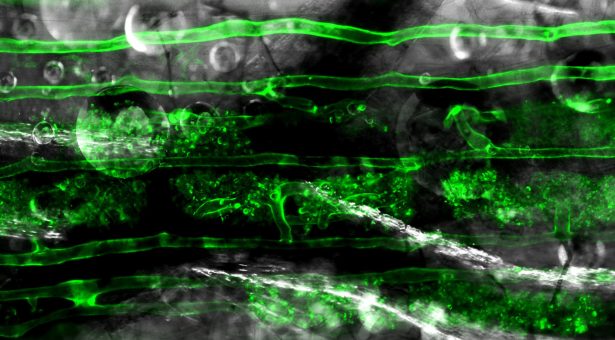Success for Catherine Jacott with new publication

The research from DTP student Catherine Jacott’s PhD has just been published in New Phytologist as a ‘rapid report’ (priority publication of particular scientific importance) (Jacott et al. 2020, DOI:10.1111/nph.16465). The research was a joint project between the John Innes Centre and the Shanghai Institute of Plant Physiology and Ecology collaborate as part of the CAS-JIC Centre for Excellence in Plant and Microbial Sciences (CEPAMS).
This publication sheds light on a long-standing enigma about why plants possess genes that appear to be detrimental to their well-being. It has long been known that the Mildew Locus O (MLO) gene causes the majority of major crops to be susceptible to the fungal leaf pathogen powdery mildew. Loss of the gene causes durable and robust resistance to the pathogen. Since MLO’s function in facilitating powdery mildew infection is disadvantageous to the host, it follows that it must also fulfil some other beneficial role that explains its conservation throughout evolutionary history.
Catherine’s PhD findings and publication show that MLO is involved in the establishment of symbiotic associations with beneficial fungi, a role that has been appropriated by powdery mildew. Using mutants from barley, wheat and Medicago truncatula, Catherine demonstrated a role for MLO in colonization by arbuscular mycorrhizal fungi. Arbuscular mycorrhizal fungi form favourable root symbioses with most land plants, including important cereal crops, such as wheat, barley and rice. This mutualistic relationship supplies water and nutrients—particularly phosphate, but also nitrogen and zinc—to the host plant.
Early mycorrhizal colonization was reduced in MLO mutants of barley, wheat, and M. truncatula, and this was accompanied by a pronounced decrease in the expression of many of the key genes required for intracellular accommodation of arbuscular mycorrhizal fungi. Further support for the hypothesis was shown by the increased expression of MLO in mycorrhizal roots and its presence in a clade of the MLO family that is specific to mycorrhizal-host species. Furthermore, using promoter-GUS assays, Catherine demonstrated that MLO is induced in root cells containing mycorrhizal fungal structures.
There is a need to develop high-yielding, disease-resistant crops and reduce dependence on inorganic fertilizer. Understanding the role of MLO in symbiotic interactions with mycorrhizal fungi is therefore vital information for sustainable agriculture. Our detailed phenotypic and transcriptomic analyses provide the basis for further elucidation of MLO function in mycorrhization and how plants balance this beneficial association with susceptibility to parasitic powdery mildews. Since mycorrhizal fungi and powdery mildew respectively infect root and shoot, it may be possible to select/generate cereal genotypes that could fully support mycorrhiza while remaining non-hosts for powdery mildew.
Additional outreach/impact includes a collaboration with artist Henry Driver (Picture credit) – commissioned by Essex County Council. Imagery from a permanent publicly displayed sculpture at Cressing Temple Barns, Braintree, Essex. Created in response, and celebrating Cressing Temple Barns’ grand history of grain storage. It uses images from Catherine Jacott and Myriam Charpentier of symbiotic relationship between crop roots and arbuscular mycorrhizal fungi.
Catherine’s PhD was supported by the Biotechnology and Biological Sciences Research Council (BBSRC).
